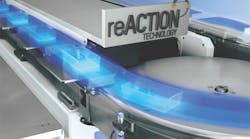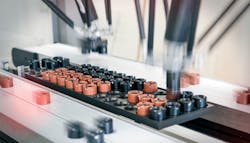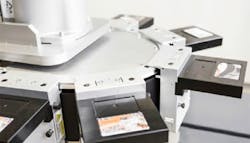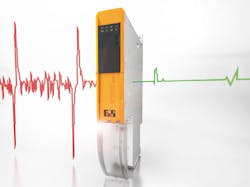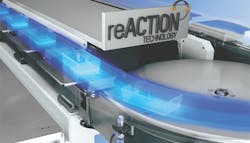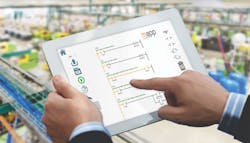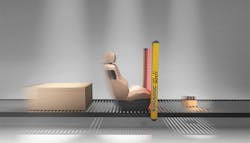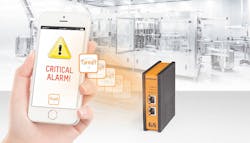The Adaptive Machine: Design Strategies & Attributes
Dedicated machine designs are giving way to base machine modules that are configured to production requirements, reconfigured as needed and support ‘batch of one’ operations.
The result is a new category of machinery, the adaptive machine.
This paper discusses attributes of adaptive machines and the enabling technologies behind the movement.
Batch Size One: The Ultimate Goal
‘Batch size one’ has become a practical reality, and in some applications may be the only realistic approach. For example, in B&R’s own manufacture of industrial PCs, there are 250 billion possible configurations – so make-to-stock is not an option. Cost effective, efficient batch of one manufacturing is the only alternative in B&R’s smart factory, and has been operational since 2009.
Today, automation technologies are being commercialized that put smart factory functionalities in the realm of real-world production and packaging applications. This new generation of machinery is required to cost effectively meet the expectations of consumers increasingly used to getting precisely what they want, quickly, online.
While additive manufacturing is a promising approach in many applications, it is not applicable to the majority of food, beverage, pharmaceutical and household goods production processes. Therefore, it will not be a subject of this paper.
While production lots, literally of one product, also don’t fit every product category, the same technologies apply to automation of rainbow packing, mass customization, short production runs with frequent changeovers and producing limited time offers. Batch size one is the ultimate invocation of these marketplace trends.
Manufacturer as Sales Channel
With a practical batch of one manufacturing and packaging capability, manufacturers can go direct to consumer, without the added steps and cost of going through an e-commerce reseller. This has the potential for manufacturers to reverse the chronic power shift from manufacturer to sales channel.
Batch size one also serves to reduce raw materials and finished goods inventory costs, the overhead cost of regional distribution centers, the cost of servicing wholesale and retail sales channels, and the discounting/disposal of unsold inventory.
Several of these benefits apply to e-commerce resellers as well. While batch size one has been elusive, its appeal to manufacturers is quite clear.
Adapting to the Unknown
Switching from glass bottles to plastic, or from rigid to flexible containers, requires completely new filling and packaging machinery. Consumer product and package lifecycles keep shrinking, while SKUs continue to expand. It is impossible to anticipate all changes -- especially disruptive ones -- that are likely to occur over the 15 to 20+ year service life of industrial machinery.
An adaptive machine will handle radical and unforeseen requirements through modularity.
An adaptive machine is one that has the capacity to change over on the fly, and moreover, to reconfigure with different production modules on the same base machine platform. It will readily be adaptable to constant size and format changes. But it will also be adaptable to radical and unforeseen requirements through corresponding equipment changes, such as replacing a carton erector module with a pouch forming module.
Adaptive machinery will compare favorably in all aspects of productivity measurement – OEE, ROI, TCO – as lot sizes shrink and throughput (leadtime and volume) requirements remain critical.
Early Adopters: Rotary Labeling Machines
Rotary labelers are examples of modular machine designs available today that can adapt to paper, film, cold glue, hot melt, self-adhesive, wraparound, front/back and neck labels among others. The correct modules, known as aggregates, are wheeled in and clamped into place. These examples come from Italy.
By individually controlling each bottle plate with a servo motor, each plate becomes an independently controlled zone – essential to the adaptive machine concept. Rotary labelers can therefore gain the flexibility to run different sizes and shapes of bottles – round, square, oval, flask -- that previously required different machines or impractical belt or cam changes.
This example is from the U.S. and also features pharmaceutical serialization, another aspect of batch size one in which each container is tracked and traced individually.
The Lure of the Racetrack
Linear transport technologies like ATS Automation™’s SuperTrak™ modular conveyor system are not a new concept. According to the company, the original SuperTrak system itself was introduced in 2002. There are other racetrack configurations on the market as well.
What differentiates the current third generation and future generations of these track systems are ongoing advances in throughput, precision, flexibility, footprint, configuration, integration with complementary technologies such as robotics, maintainability and cost.
Linear transports like this SuperTrak™ system are the core of the adaptive machine.
The core of the adaptive machine, a track system is really much more than a modular conveyor – this new generation of industrial transport technology doesn’t just move products to work stations, it performs work while products are in transit.
Redefining Flexibility
Independently controlled shuttles deliver the adaptive machine’s unsurpassed flexibility.
New generation track systems are variable pitch, meaning that each shuttle is independently controlled, with movements that can be synchronized to prevent bottlenecks and the need for accumulation buffers.
For example, a shuttle with a payload that requires 4 seconds to process can be synchronized to a process that performs a 2-second process on two shuttles, or a 1-second process on four shuttles, and so on. Production planning for variable pitch functionality optimizes production efficiency.
Current linear track systems can mount horizontally or vertically for added flexibility without reducing bearing life. And they can be positioned around obstructions such as existing building columns. It is important to note that current generation tracks can utilize workspace above, below, inside and outside the track. Older designs could not, because spaces were filled with componentry.
Maintain Control over Product at all Times
It is subtle but critical to efficiency and consistency. Once a machine has a product or package under physical control, it is inefficient to lose that control while transferring from process to process. Uncontrolled product flow is very common, as in a typical bottling line, and can lead to scuffing, line jams and product loss.
In conventional packaging lines this may be accomplished by conveyors fitted with lugs, pucks or even vacuum belts. In assembly and machining lines, parts and products may be fixtured on jigs, ‘tombstones’ or pallets.
Both approaches tend to be rigidly sequential.
In the adaptive machine, fixturing still may be used to maintain positive control over the product, but in a much more flexible environment. Variable pitch, multidirectional travel, and synchronized movements of the shuttle, robot arms, actuators, printheads and other devices mean that the process adapts to the product, not the other way around.
Example: Turning Robots into Filling Lines
This company, based in Asia, has taken an off-theshelf approach that represents another evolutionary step toward the adaptive machine. They’ve implemented filling heads as end-of-arm tooling on robot arms, holding containers in pucks to maintain control, and recreated the inline motion profile of a walking-beam.
Their initial design strategy for using robots?
They had never designed a packaging machine, so they opted for commercially available robot arms and synchronized them to the conveyor system, effectively achieving the modular and reconfigurable aspects of the adaptive machine.
Example: ≤4 Second Changeover
Machinery from a Spanish company erects, fills and closes up to four different sized cases on demand, at rates of 20 cases per minute, capable of changing case sizes in 4 seconds or less, programmable with 99 recipe-driven case formats and corresponding lid formats.
They do look like conventional machines with the addition of automated size change equipment, and they are purposebuilt. But imagine a racetrack consecutively feeding different sized products going into different sized cases at very respectable production rates.
It’s mass customization without a throughput penalty. And it is well suited to e-commerce fulfillment because shippers like FedEx and UPS are now charging by package size in addition to weight.
Math over Physics
Anti-sloshing algorithms seem to defy the laws of physics.
Automation technology providers continue to develop algorithms to compensate for physical, mechanical and electrical limitations. Anti-sloshing, combined with the new track technology, allows faster movement of open containers of liquids without spilling. This is another motion control software functionality that provides precisely controlled, gentle acceleration and deceleration despite fast movement.
Likewise, certain mechanical conditions can cause periodic disturbances in servo-controlled machinery. A repetitive control algorithm can be used to predict and compensate for those fluctuations. It’s an active form of suppression that undergoes a constant learning process to adapt to changes in disturbance, such as may be caused by wear.
Simulation vs. Prototyping
One of the most effective design tools to test multiple variables prior to cutting metal is simulation. Traditionally, simulation hasn’t been widely applied on purpose-built machines because they tend to be variations on established designs or so highly customized that simulation is considered cost prohibitive. With the advent of racetrack modules, the automation supplier has the justification to provide simulation capabilities as part of the solution. There actually is no prototype with these systems. The machine modules are configured rather than built from scratch, and the customization lies more in layout, tooling, fixturing, and optimizing the number, movement and dimensions of devices, shuttles and workstations.
Those variables are ideally suited to simulation, resulting in an optimized design, faster, at less cost.
The off-the-shelf modularity of adaptive machine subsystems makes simulation tools practical.
How Would you Spend 1 μsec?
A perfect example of Moore’s Law, the intelligent ‘fast reaction’ I/O slice can respond in as little as one microsecond. At first that may appear to be overkill. But at the high cycle rates, synchronization and small footprints associated with track-based production systems, this rapid response represents yet another enabling technology.
Going back to the case packing machine described earlier that can change formats in under 4 seconds – microseconds count! Microseconds also count in empty-wrap detection/rejection for flow wrappers operating at over 1,000 candy bars per minute, firing glue guns more precisely to reduce adhesive overspray, and in safety system response.
The latest iteration of the high speed I/O slice is, in fact, a safety I/O module.
Innovations Abound
It is the combination of many seemingly small innovations such as these that combine to enable the adaptive machine:
One recent example is HTML5 based human-machine interfaces that run on any web-enabled device regardless of operating system.
This makes it much simpler to fulfill the popular concept of deploying remote visualization on any phone, tablet or computer screen--without needing to support versions for Android, iOS, Windows, Linux or any other operating systems for that matter.
The user experience also improves, because the HMI can now have the familiar feel and navigation of web pages, benefiting from the latest HTML 5, JavaScript and Cascading Style Sheet web design standards.
Another is networked safety, which replaces hardwired safety. Networked safety has spawned both new diagnostic capabilities and safe motion, in which the machinery continues to operate in a safe mode rather than shutting down.
Simplifying production of small batch sizes, software modules to program network integrated light curtains now make it possible for objects of different sizes and shapes to pass through without triggering a safety response – perfect for batch size one products of different sizes and shapes.
Safe robotic control will also be key to the expanded use of collaborative robots.
Combined with condition monitoring to enable predictive maintenance and energy monitoring to optimize efficiency, these software innovations and others, available today, are making the adaptive machine a practical reality.
And, machine applications can now Tweet, sending information via text message or email to communicate alerts instantly.
Automated text messaging allows a machine application to send text messages and emails triggered by specific events and can easily be connected to other software components, such as alarms, to automatically notify a maintenance technician when immediate action is required.
Tweets can be supplemented with additional information, such as troubleshooting instructions that allow the technician to quickly and efficiently resolve the root cause.
Conclusions
- Adaptability pertains to consumer expectations, market strategies, product and package changes and line extensions
- Adaptive machines are defined by individually controlled modules with multidirectional movement, tight synchronization of modules and other (often robotic) devices, and exceptional production flexibility
- New and next generation linear track systems are core to the adaptive machine -- unlike conveyors, track systems can perform work on products while in transit
- Consideration should be given to complementary production technologies as well as to the level of advanced automation technology enabling the adaptive machine when researching adaptive machine solutions
- The business case for the adaptive machine is justified as batch size shrinks and throughput requirements remain critical, and is measurable by proven -- OEE, ROI, TCO – methods
